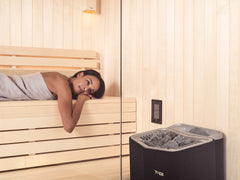When it comes to relaxation and rejuvenation, few experiences rival the soothing warmth of a sauna or steam room. Both offer benefits to your body and mind, but deciding which one is best for you can be a heated debate! We'll delve into the characteristics, advantages, and disadvantages of saunas and steam rooms, answering your frequently asked questions to help you make an informed choice. Let's get started...
What is a sauna?

A sauna is a small room designed to experience dry heat, typically achieved by heating rocks, stoves, or more recently, infrared panels. Saunas are characterised by their high temperatures, often ranging from 71°C to 93°C - or 38-65 °C for infrared saunas - with low humidity levels.
What is a steam room?
A steam room is a confined space designed to experience wet heat, a generator filled with boiling water provides the steam. Unlike saunas, steam rooms maintain a lower temperature, usually around 43°C to 49°C, but have significantly higher humidity levels, often reaching 100%.
What exactly does a sauna do?
Saunas induce sweating due to the dry heat, which helps cleanse the body of toxins, improves circulation, and aids in muscle relaxation and recovery. The drier heat also boosts the immune system and stimulates the release of endorphins, leaving you relaxed and de-stressed. Find out more about the health benefits of saunas in our blog.
What does a steam room actually do?

Steam rooms create a humid environment that makes you feel like you’re sweating, but the sensation is more likely moisture droplets from the air, rather than from your body. Steam opens up the pores, allowing for deep cleansing, detoxification, and hydration of the skin. The moist heat can also alleviate respiratory issues, such as congestion and asthma.
What are the disadvantages of a sauna?
While saunas offer numerous benefits to your wellbeing, they should be avoided if you're pregnant, and can pose risks if you suffer from certain health conditions, such as heart disease or high blood pressure. Dry heat can also worsen skin conditions like dermatitis or fungal diseases, so use your sauna wisely. Prolonged exposure to high temperatures can also lead to dehydration and overheating if not properly hydrated. Get more advice about sauna safety in our blog.
What are the disadvantages of a steam room?
Steam rooms, while beneficial for a lot of us, should also be avoided if you're expecting a little one, and can also exacerbate respiratory conditions due to high humidity levels. Moist environments can also increase the growth of bacteria and mould if not adequately maintained, which can aggravate allergies and asthma. Don't forget to drink plenty of water before and after your session, to reduce the risk of dehydration - your skin may feel hydrated but your body isn't! Get tips on cleaning your sauna in our guide.
Should you sauna or steam first?

There's no hard and fast rule, and steam room and sauna advocates often disagree! We prefer to start with a sauna session for gradual acclimatisation to the heat before you experience the humidity of a steam room, we also find our muscles are more relaxed and our pores feel cleaner. Don't forget to always keep hydrated before, in between, and after any session.
Is a sauna or steam room better for weight loss?
Steam rooms and saunas don’t technically burn fat, but they do help to burn slightly more calories than you would otherwise. The higher temperature causes your heart rate to increase, in a similar way to exercise. Be mindful that any immediate weight loss you experience could be water loss from dehydration, so make sure to drink plenty of water. Don't consider a sauna or steam room a weight loss miracle, but rather a complementary tool in your fitness arsenal, along with a healthy diet and regular exercise.
Is it better to go in the steam room or sauna after a workout?
Both a sauna and steam room can be beneficial after a grueling workout, helping relax muscles and promote recovery. However, we find steam rooms more soothing for sore muscles due to the moist heat, while saunas offer a more intense detoxifying experience.
How long to stay in a sauna vs. a steam room?

It's the length of sauna and steam sessions instead of the regularity that you need to be mindful of. Longer sessions over 20 minutes can dehydrate you, whereas regular stints should not pose a risk to your health, in fact, the more often you use it, the more benefits you’re likely to get. Beginners should start with shorter sessions, gradually increasing duration as they acclimate to the heat. It's essential to listen to your body and stop if you start feeling lightheaded or uncomfortable.
Is it okay to use a sauna and steam room every day?
If you're a newbie, aim to start with weekly steam or sauna sessions. It's usually fine to use one every day, as long as you stay hydrated. Moderation is key, and it's essential to monitor how your body responds to frequent heat exposure. If you have any underlying health concerns, it's important to consult with your doctor before incorporating sauna or steam sessions into your routine.
Parting advice
The choice between a sauna and a steam room depends on your lifestyle, health concerns, and personal preference. The main difference is due to the levels of humidity and temperature. Ultimately, it comes down to your comfort with heat and humidity, along with the wellbeing benefits you’re looking for.





